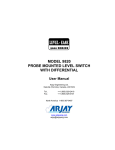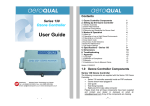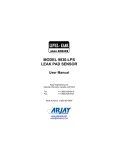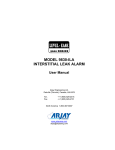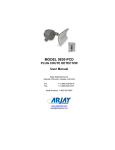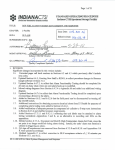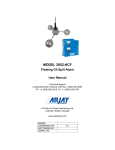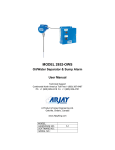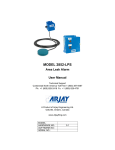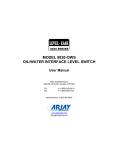Download model 9820-ows oil/water separator level switch
Transcript
MODEL 9820-OWS OIL/WATER SEPARATOR LEVEL SWITCH User Manual Technical Support Continental North America Toll Free 1-(800) 387-9487 Ph: +1 (905) 829-2418 Fx: +1 (905) 829-4701 A Product of Arjay Engineering Ltd. Oakville, Ontario, Canada INTERNET www.arjayeng.com 9820 | 9830-OWS Oil / Water Separator Level Alarm Reliable interface monitoring of oil/water separators, sump pits and containments for pump control and alarm Over 30 years of Arjay’s field proven HF capacitance technology has been applied to the 9820/9830-OWS oil water separator alarms. The sensing probe continuously monitors for oil to control pumps, operate valves, or activate alarms. • capacitance technology does not foul or require cleaning • no moving parts • remote alarm unit mounts safely away from pipe 9820 | 9830-OWS The 9820/9830-OWS sensing probe monitors the capacitance field around the active probe tip. As the volume of separated oil increases in the separator or is drawn down toward the probe tip, the probe capacitance changes. This change is used to activate the relay for alarm interface and control. Features and Benefits Technical Specifications - Control Unit • no moving parts • remote electronics via standard twisted pair • available with Intrinsic Safety Barrier for Hazardous Locations • high corrosion resistant Teflon and stainless steel wetted parts • capacitance technology responds to all oil types • HF capacitance technology does not require routine cleaning • easy calibration and control set-up All calibration, control relays and power wiring is available at the main control unit. This can be safely mounted up to 1 km away from the sump. Operating Temperature Power Input Alarm Relay Standards Enclosure -20˚C to 60˚C 24 vdc or 110 vac or 220 vac 5 amp, DPDT, dry UL, CSA Type 4X Technical Specifications - Sensor Operating Temperature Approval The Model 9820-OWS version provides the electronics mounted directly to the probe for economical and compact installations. Arjay Engineering Ltd. 2851 Brighton Road Oakville, Ontario Canada L6H 6C9 tel fax N. America email web 0˚C to 50˚C CSA Class 1, Zone 2, Div 2, Groups A,B,C,D (also available with an Intrinsic Barrier on the 9830-OWS) The unique PMC circuit design, exclusive to Arjay, immediately converts the sensor signal to a frequency pulse for furtherance to the controller (9830 version). ++1 905-829-2418 ++1 905-829-4701 1-800-387-9487 [email protected] www.arjayeng.com MODEL DOCUMENT TYPE DOCUMENT FILE NAME REV. 9820-OWS LEVEL SWITCH USER MANUAL 9820OWSUM12.DOC 1.2 CREATE DATE REV. DATE PRINT DATE October 18, 2001 3:25 PM October 18, 2001 3:25 PM August 3, 2005 12:31 PM TABLE OF CONTENTS 1.0 2.0 3.0 4.0 5.0 INSTRUMENT OVERVIEW............................................................................................ 3 1.1 FEATURES ....................................................................................................... 3 1.2 DESCRIPTION .................................................................................................. 3 1.3 SPECIFICATIONS............................................................................................. 4 INSTALLATION .............................................................................................................. 5 2.1 PROBES............................................................................................................ 5 2.1 ELECTRICAL INSTALLATION.......................................................................... 6 STARTUP AND CALIBRATION ..................................................................................... 7 3.1 CALIBRATION OVERVIEW .............................................................................. 7 3.2 POWERUP ........................................................................................................ 7 3.3 SINGLE POINT LEVEL SWITCH CALIBRATION............................................. 7 3.4 ALARM SETTINGS ........................................................................................... 8 TROUBLESHOOTING ................................................................................................... 10 DIMENSIONAL AND ELECTRICAL DRAWING ........................................................... 10 HARDWARE REV. SOFTWARE REV. 3.0 9820_05 and higher Page 2 of 10 MODEL DOCUMENT TYPE DOCUMENT FILE NAME REV. 9820-OWS LEVEL SWITCH USER MANUAL 9820OWSUM12.DOC 1.2 CREATE DATE REV. DATE PRINT DATE October 18, 2001 3:25 PM October 18, 2001 3:25 PM August 3, 2005 12:31 PM 1.0 INSTRUMENT OVERVIEW 1.1 FEATURES • • • • • • • • • Push-button calibration RF Technology Integral or optional remote level probe Double pole Double Throw (DPDT) 5A relay contacts 0 – 20 second time delay Adjustable sensitivity High or Low relay action No moving parts For use with any Arjay Capacitance probe 1.2 DESCRIPTION The unit senses an oil/water interface using an RF capacitance measurement technique together with microcontroller technology for high resolution measurements. A probe mounted in a vessel forms a capacitor with the vessel wall, or with a concentric shield around the probe for non metallic vessels (ground reference). The capacitance of this arrangement is measured by the 9820-OWS and is used to provide point level switch control. The 9820-OWS RF capacitance measurement technique minimizes the effects of other electrical properties of the probe, vessel and the vessel contents and focuses only on the vessel capacitance. The level switch is available with an integral level probe or optional remote probe which may be located up to 1 km away (see Model 9830-OWS). The 9820-OWS will alarm when a preset level of oil is reached. The Oil/Water Separator must be of the type that the point of alarm (probe tip ) is permanently covered with water under normal conditions. Otherwise, a dry conditon will indicate an alarm condition. The water is gradually displaced from the vessel as the oil is introduced. The control relay is always in failsafe mode. The relay action may be set for high or low acting. MODEL 9820 DIFFERENTIAL LEVEL SWITCH INTEGRAL WITH PROBE OPTIONAL REMOTE PROBE 2 WIRE (SHIELDED) DPDT 5A RELAY INTRINSIC SAFETY BARRIER (OPTIONAL) BLOCK.DSF 115VAC / 220VAC 24VDC (Optional) LARGE VARIETY OF STANDARD CAPACITANCE PROBE STYLES REMOTE CAPACITANCE LEVEL PROBE Figure 1.0 HARDWARE REV. SOFTWARE REV. 3.0 9820_05 and higher Page 3 of 10 MODEL DOCUMENT TYPE DOCUMENT FILE NAME REV. 9820-OWS LEVEL SWITCH USER MANUAL 9820OWSUM12.DOC 1.2 CREATE DATE REV. DATE PRINT DATE October 18, 2001 3:25 PM October 18, 2001 3:25 PM August 3, 2005 12:31 PM 1.3 SPECIFICATIONS OPERATION USER INTERFACE Instrument status Alarm Status Time delay Relay action Dielectric switch The unit uses an RF Capacitance measurement technique for high resolution measurements. A sheathed probe mounted in a Oil/Water separator forms a capacitor with the vessel wall. The capacitance of the water is measured by the 9820-OWS and a change from water to oil changes the capacitance, therefore providing point level switch control. 2 color indicator: Green for normal operation, Red = instrument error, Red for calibration confirmation. Red indicator: On when normal (water), Off when in alarm (oil). 0 – 20 seconds. High or Low relay action. Typical setting for OWS applications is Low. This will keep the relay energized at all times when the probe is in water. An alarm (oil) condition will de-energize the relay. Used to indicate to the unit if the probe is in a water or oil state at the time of calibration. Typical calibrations are under a normal condition (water) and the switch is set to high (water being the higher dielectric of water vs. oil) PERFORMANCE Resolution The unit measures capacitance in pF. Capacitance to Level translation depends on the tank geometry and the type of material being measured. Capacitance: 0.4% of measured capacitance. Example: at 50pF, the resolution is 0.2pF and at 100pF, the resolution is 0.4pF. For a 5 ft. vertical, concentrically shielded probe in water, this translates to about 0.2” of level. For shorter probe lengths the resolution is higher (0.1” for a 2.5 ft. concentrically shielded probe). PROBE CONNECTION None for integral probe (standard) unit: Factory wired internal to enclosure. For optional remote probe units: 2 wire + shielded cable to probe. RELAY Contacts Failsafe. DPDT 5A (resistive load) /250VAC/30VDC dry contacts. Selectable high or low acting alarm. POWER 115VAC or 220VAC @ 25mA max. 24VDC @ 60mA max. 12VDC @ 75mA max. MECHANICAL SPECIFICATIONS Enclosure Standard: Probe mounted. Dimensions /Weight 3.75” (95mm) diam. x 5.25” (133mm) high / 3lbs. (1.4kg) ENVIRONMENTAL SPECIFICATIONS Operating Temp. -20 to 60°C for Controller only. For remote probe:-40 to 80°C Relative Humidity 90% max. with no condensation. HARDWARE REV. SOFTWARE REV. 3.0 9820_05 and higher Page 4 of 10 MODEL DOCUMENT TYPE DOCUMENT FILE NAME REV. 9820-OWS LEVEL SWITCH USER MANUAL 9820OWSUM12.DOC 1.2 CREATE DATE REV. DATE PRINT DATE October 18, 2001 3:25 PM October 18, 2001 3:25 PM August 3, 2005 12:31 PM 2.0 INSTALLATION 2.1 PROBES NOTE: If any damage to the instrument is found, please notify an Arjay Engineering representative as soon as possible prior to installation. The probe length will vary from one system to another. The length is measured from the probe entrance fitting to the desired point of interface alarm. Teflon coated probes with a stainless steel inactive sheath are the standard with 4 inches of active probe exposed. Standard probe entry in to a tank is via a 3/4" NPT opening (standard probes) or 1" NPT opening (heavy duty probes). Flanges and concentric shields are available as options. The entrance configuration may vary depending on the application requirements. TO SCREW IN PROBE (THREADED ENTRY) USE WRENCH ON LOWER HEX. The probe fittings are compression type with Teflon ferrules assembled by applying torque between the two hex sections. The fittings are sealed at the factory to provide a compression seal capable of withstanding high pressures. Once opened they cannot be reassembled without replacing the ferrules. CAUTION: INSTALL PROBE WITH CARE: DAMAGE TO TEFLON SHEATH WILL CAUSE MEASUREMENT ERRORS. THREADED ENTRY FLANGED ENTRY CONCENTRIC SHIELD ENTRY Use wrench on Lower Hex ONLY 2" Entry Typical 1- For threaded and flanged entry types, measurement sensitivity is increased by reducing the probe to wall distance. 2- There should be good electrical conductivity between the tank wall and the transmitter enclosure. (For probes with a concentric shield this is not important). INSTALL PROBE WITH CARE: IF TEFLON COATING IS DAMAGED, THE PROBE WILL NOT WORK PROBE.DSF PROBE INSTALLATION Figure 2.0 HARDWARE REV. SOFTWARE REV. 3.0 9820_05 and higher Page 5 of 10 MODEL DOCUMENT TYPE DOCUMENT FILE NAME REV. 9820-OWS LEVEL SWITCH USER MANUAL 9820OWSUM12.DOC 1.2 CREATE DATE REV. DATE PRINT DATE October 18, 2001 3:25 PM October 18, 2001 3:25 PM August 3, 2005 12:31 PM 2.1 ELECTRICAL INSTALLATION ALARM STATUS Single DPDT relay with dry contacts rated at 5A @ 250VAC or 30VDC for resistive loads. DPDT RELAY NO C CALIBRATE NC DIELECTRIC LOW NO C HIGH SENSITIVITY Terminals marked + and - are for DC power units. POWER NC GND ALARM DELAY L2 (-) RELAY L1 (+) LOW HIGH PROBE IN + PROBE WIRING (FACTORY WIRED) MODEL 9820 DIFFERENTIAL LEVEL SWITCH POWER: 115VAC power is standard. For 220VAC, 24VDC or 12VDC units power must be stated at time of order. For DC power units, the L1 terminal is to be connected to the positive supply, and the L2 terminal for the negative supply. ELECT.DSF ELECTRICAL INSTALLATION Figure 2.2 NOTE: 115VAC power is standard. Other power supply voltages are supported (220VAC. 24VDC, 12VDC) and must be specified at time of order. APPLYING POWER OTHER THAN THAT MEANT FOR THE UNIT MAY CAUSE DAMAGE AND OR INJURY. HARDWARE REV. SOFTWARE REV. 3.0 9820_05 and higher Page 6 of 10 MODEL DOCUMENT TYPE DOCUMENT FILE NAME REV. 9820-OWS LEVEL SWITCH USER MANUAL 9820OWSUM12.DOC 1.2 CREATE DATE REV. DATE PRINT DATE October 18, 2001 3:25 PM October 18, 2001 3:25 PM August 3, 2005 12:31 PM 3.0 STARTUP AND CALIBRATION ALARM STATUS CALIBRATE Calibrate Pushbutton DIELECTRIC Dielectric: Set to high if probe tip is in water (normal condition). Sensitivity: Set to 3 for OWS. HIGH 9 0 1 8 7 SENSITIVITY 6 5 4 2 3 LOW 9 0 1 6 5 4 2 3 Alarm delay: 0 - 20sec. Each switch inc. = 2sec except 6=15 and 7=20. 8&9 not used = 0sec. 8 7 ALARM DELAY Sets alarm direction: above or below alarmpoint RELAY LOW HIGH PROBE IN + MODEL 9820 DIFFERENTIAL LEVEL SWITCH USERINT.DSF USER INTERFACE Figure 3.0 3.1 CALIBRATION OVERVIEW Calibration and switch settings are determined by the type of probe and application. Factory calibration can not be done because each application has different ground references as well as probe lengths which cause a different offset capacitance. 3.2 POWERUP After the unit has been installed as per the installation procedure in section 2, power up the unit. The Status indicator should be Green. The red Alarm indicator may be on or off and is not valid until a successful calibration has been done. If the Status indicator is red refer to the troubleshooting procedure in section 5.0 for details. 3.3 SINGLE POINT LEVEL SWITCH CALIBRATION HARDWARE REV. SOFTWARE REV. 3.0 9820_05 and higher Page 7 of 10 MODEL DOCUMENT TYPE DOCUMENT FILE NAME REV. 9820-OWS LEVEL SWITCH USER MANUAL 9820OWSUM12.DOC 1.2 CREATE DATE REV. DATE PRINT DATE October 18, 2001 3:25 PM October 18, 2001 3:25 PM August 3, 2005 12:31 PM NOTE: CALIBRATION SHOULD BE DONE WITH THE OIL/WATER SEPARATOR FILLED WITH WATER and probe tip is submerged in the water. For Oil/Water applications set the switches of the 9820 controller as follows: ALARM DELAY Position “7” SENSITIVITY Position “3” RELAY Low failsafe DIELECTRIC High dielectric 1. Press the Calibrate push-button until the status indicator glows red. Release and the status indicator then starts flashing green indicating that the unit is in the calibration mode. 2. Press the Calibrate push-button again until the status indicator glows red. Release. The unit is now calibrated and the status led should go to steady green and the alarm status led will be red, indicating a normal condition with a failsafe to alarm setup. Please refer to section 3.5 below for setting the time delay and relay action. 3.4 ALARM SETTINGS The relay is always in the failsafe condition: i.e. in alarm condition, the relay is de-energized and alarm light is off which would be the same if a power failure were to occur. There are 3 alarm settings: 1. RELAY ACTION. When the Relay Action switch is set to Low, the failsafe relay is de-energized and alarm indicator is off when the level changes to oil. Under normal conditions the probe tip is submerged in water and the relay is energized and the alarm indicator is on. 2. ALARM TIME DELAY. This is set via the Time Delay switch. An alarm must be present for at least the time delay value for the relay to switch to the alarm state. The delay range is 0 – 20 seconds. DELAY SWITCH SETTING TIME DELAY 0 0 seconds 1 2 seconds 2 4 seconds 3 6 seconds 4 8 seconds 5 10 seconds 6 15 seconds 7 20 seconds 8&9 Not used and act as 0 seconds. HARDWARE REV. SOFTWARE REV. 3.0 9820_05 and higher Page 8 of 10 MODEL DOCUMENT TYPE DOCUMENT FILE NAME REV. 9820-OWS LEVEL SWITCH USER MANUAL 9820OWSUM12.DOC 1.2 CREATE DATE REV. DATE PRINT DATE October 18, 2001 3:25 PM October 18, 2001 3:25 PM August 3, 2005 12:31 PM 3. SENSITIVITY SETTING The switch setting is used to add to or subtract from the calibrated level value to make it more or less sensitive to a change from water to oil . Most oil/water applications require the setting to be adjusted to 3. THIS COMPLETES THE SETUP AND CALIBRATION PROCEDURE FOR THE 9820-OWS LEVEL SWITCH HARDWARE REV. SOFTWARE REV. 3.0 9820_05 and higher Page 9 of 10 MODEL DOCUMENT TYPE DOCUMENT FILE NAME REV. 9820-OWS LEVEL SWITCH USER MANUAL 9820OWSUM12.DOC 1.2 CREATE DATE REV. DATE PRINT DATE October 18, 2001 3:25 PM October 18, 2001 3:25 PM August 3, 2005 12:31 PM 4.0 TROUBLESHOOTING CONDITION 1. No indicators on at powerup 2. Status indicator is RED DO THIS Check power to unit. Make sure power applied is as specified for the unit. If power is ok, check the fuse. If fuse is blown call an Arjay representative to analyze why the fuse in blown. This indicates that the probe signal is either weak, unstable, out of legal range, or is not present. Unplug the probe connector to the 9820. The probe wiring is internal to the enclosure on standard units. The probe wire comes up from the bottom of the enclosure and plugs to the 9820 circuit board. If status indicator is green after unplugging the probe then check the probe as follows: With the probe connector unplugged, measure the resistance with a digital resistance meter between the minus of the probe (as marked on the front plate) and the enclosure case. For a good probe, the resistance should read open (OL on the meter display). Any other value indicates a bad probe. In either case, call an Arjay representative or Arjay Technical support. HARDWARE REV. SOFTWARE REV. 3.0 9820_05 and higher Page 10 of 10













